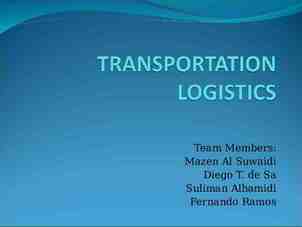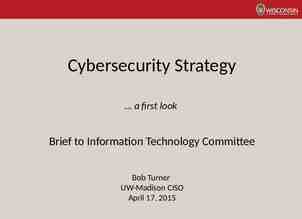Overview of the Incident Command System U.S. Department of Agriculture
30 Slides2.40 MB

Overview of the Incident Command System U.S. Department of Agriculture Forest Service

ICS in a Tsunami Response Context Regional Tsunami Warning Center (seismic and tsunami data collection and interpretation) National Focal Point for Tsunami Warning Disaster Response Activated: Incident Command System National to Local Warning Dissemination

Global Trends Towards Increasing Disaster Complexity Population growth and spread of urban areas Greater life, property loss from natural and human caused technological disasters Language and cultural differences More multi-jurisdictional incidents Need to share resources More complex and inter-related incident situations Sophisticated media coverage Complicated cost decisions on incidents

1970s Scenario: Disaster Management Challenges in the US Too many people reporting to one supervisor Different emergency response organizational structures Lack of reliable incident information Inadequate and incompatible communications No mechanism for coordinated planning between agencies Unclear lines of authority Terminology differences between agencies Unclear or unspecified incident objectives

Origins of the Incident Command System 1970s – recognition of the need for a standardized system of disaster response USDA Forest Service (USFS) tasked as lead agency to develop a better system 1980s - ICS adapted for all-hazard emergency and disaster response Now utilized for all emergency/disaster response in the US and introduced to other countries

What is ICS? Single standardized incident management system used by all emergency response disciplines Multi-hazard disaster response leadership structure for COMMAND AND MANAGEMENT: specific technical competency skills are integrated in the ICS organization Provides accurate information, strict accountability, planning, and cost effective operations and logistical support for any incident

National Incident Management System (NIMS) – March, 2003 Presidential Directive that mandates use of the National Incident Management System (NIMS) Establishes a single, comprehensive, and common national approach to domestic incident management, used by all levels of government

NIMS Command and management Preparedness Resource management Communications and information management Supporting technologies Ongoing management and maintenance

US Government Structure and Context of ICS Multiple agencies and jurisdictions at the local, state, and federal levels Recognized need for resource sharing Decentralized decision making authority for emergency response – local levels

US Government Structure and Context of ICS (cont) Delegation of authority to emergency management specialists ICS positions based on expertise and qualifications The US has a vast pool of technical response units for all types of disasters

Basic ICS Concepts The ICS is a multi-hazard disaster response management organization structure: specific technical competency skills are integrated in the ICS organization ICS used on day-to-day basis for routine incidents as well as for major emergencies; activated at first response

Basic ICS Concepts Command vs. Coordination Command is the direct management of the on-scene operations Coordination and support functions serve the needs of the command function – generally located away from the site

Basic ICS Concepts Non-Permanent Organization The ICS is activated in response to an emergency NOT a permanent organizational structure or secretariat During an emergency, ICS qualified personnel leave “regular” positions

Basic ICS Concepts Delegation of Authority The responsible official establishes policy, direction, parameters, and delegates authority to the Incident Commander Responsible official generally not at scene all the time but maintains contact as necessary.

Responsible Official Local Incident Inciden Commander t Type 2 Incident Comm Commander ander Type 1 Incident Commander

Incident Command System Capabilities Provides for a single management system for multi-jurisdictional incidents Modular - Allows expansion and contraction depending on size and complexity of incident Used on any type or size of incident

Incident Command System Capabilities (cont.) Structured to integrate any type of resource including police, military, technical experts, and NGOs Can be used to manage sudden onset disasters, long-term relief efforts, or non-emergency events

ICS Major Organization Functions Incident Incident Commander Commander Information Information Safety Safety Liaison Liaison Operations Operations Planning Planning Logistics Logistics Finance/ Finance/ Administration Administration

Examples of US Incidents Using ICS Exxon Valdez Oil Spill – 1989 Hurricane Iniki, Hawaii – 1992 Northridge Earthquake – 1993 Oklahoma City bombing – 1995 World Trade Organization Riots - Seattle 1999 Pentagon, World Trade Center terrorist attack – 2001

Examples of US Incidents Using ICS Winter Olympics Salt Lake City security plan – 2002 Exotic Newcastle’s Disease, California – 2003 Columbia Space Shuttle Recovery – 2003 Political Conventions – 2004 Hurricanes – 2004, 2005, 2006 Wildfires

ICS – An Evolving System No quick solutions On-going evaluation Hard work, compromise and commitment Commitment to interagency training, simulation exercises, and drills Combination of political will and administrative machinery are critical

ICS and the USDA Forest Service (USFS) Lead agency to develop the ICS USFS fields largest numbers of personnel serving on Incident Management Teams International Arena: Disaster Mitigation Programs and Disaster Assistance Support Program USFS annually conducts interagency training in all aspects of ICS international training

Countries in which USFS Conducted ICS Courses Canada India Australia Sri Lanka Mexico Association of Bulgaria Southeast Asian Nations (10 member countries) Mongolia

Countries Using ICS United States Canada Australia New Zealand Mexico (in transition for wildland fire) India (in transition) United Nations – FAO and UNICEF deliberating use ICS is emerging as the “common language” of disaster response globally

ICS in Asia India - ongoing since 2002 Ministry of Home Affairs – focal point LBSNAA – Indian Admin Service training partner ASEAN - On-going since 2004 ASEAN Committee on Disaster Mgmt – focal point Regional application Sri Lanka -on-going since 2005 Disaster Management Centre – focal point SLIDA – training partner

ICS Integration Strategy Phase 1 – Foundation and System Adaptation Phase 2 - Formal training-of-trainers course curriculum in ICS (8 courses) Phase 3 – Implementation of ICS, establishing teams, simulation exercises

Phase 1: Foundation and System Adaptation Identify partner institutions Brainstorming workshop and consultations Develop ICS framework document with adaptations to government and cultural context Develop comprehensive training plan with focal training institution, curriculum, train-thetrainer scheme Develop time line of collaborative activities to integrate ICS into disaster response system

Phase 2: Train-the-Trainer ICS Course Curriculum Adapt course materials to country context Conduct an 8-course ICS curriculum covering all aspects of the system Provide training materials for all courses to focal training institution Conduct study tours to the U.S. on disaster management Monitor first offerings of ICS course by country trainers

Phase 3: Implementation Activities Provide technical consultation to assist establishing system and teams Facilitate disaster simulation exercises

Thank You For your kind attention






